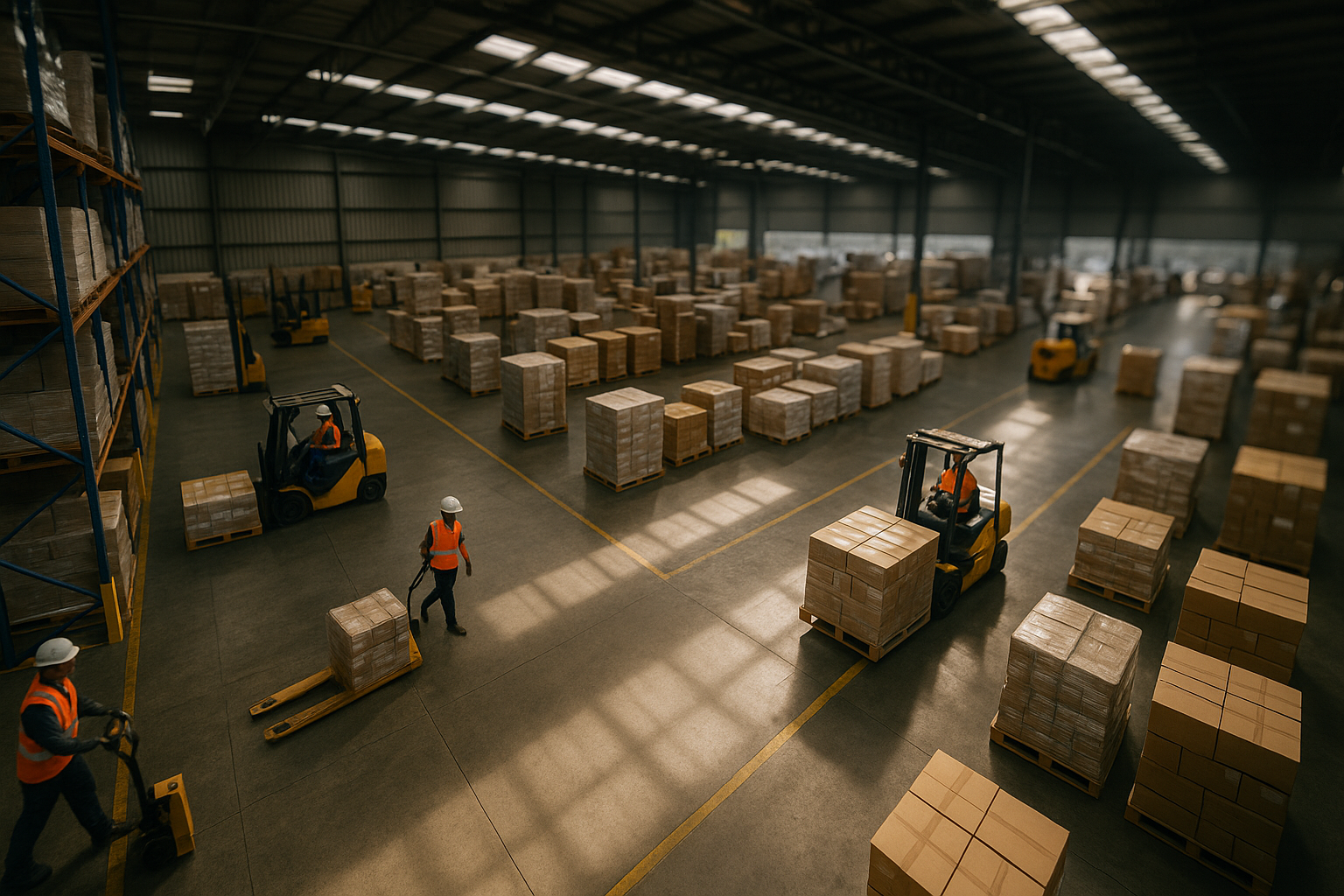Freight performance is the backbone of a successful supply chain.
Freight performance is the backbone of a successful supply chain. Whether you're managing a logistics company, handling transportation for a large corporation, or simply optimising your business operations, understanding the key metrics to track freight performance is crucial. With the right tools like Cario, freight performance metrics help companies monitor efficiency, ensure timely deliveries, and reduce costs. With so many variables affecting logistics, it is important to focus on key performance indicators (KPIs) that will give you the most actionable insights into your operations.
In this article, we'll discuss the essential freight performance metrics that companies in the logistics and transportation sector must track. From delivery speed to cost efficiency, we will cover how these metrics help improve operations and drive decision-making.

Why Freight Performance Metrics Matter
In an increasingly competitive global market, the ability to deliver products quickly, efficiently, and at the right cost can be a significant differentiator. For freight people, those in the logistics, shipping, and transportation industries, tracking the right metrics is fundamental to business growth. By focusing on these KPIs, businesses can streamline operations, improve customer satisfaction, and boost their bottom line.
The key to improving freight performance lies in identifying and monitoring the right metrics. These metrics provide actionable insights into every stage of the supply chain and help make informed decisions regarding resources, routes, and technologies.
Key Freight Metrics to Track
1. On-Time Delivery (Otd)
On-time delivery (OTD) is perhaps the most critical metric for freight performance. It refers to the percentage of deliveries made within the agreed-upon time frame. For both customers and freight companies, timely deliveries are vital for operational success. A high OTD rate is an indicator that the freight network is running smoothly, while a low rate highlights inefficiencies or potential bottlenecks.
Why OTD is Important
Tracking OTD helps companies gauge customer satisfaction and operational effectiveness. Late deliveries can lead to penalties, lost revenue, and customer dissatisfaction. By monitoring this metric, companies can pinpoint where delays occur, whether it's with the supplier, the freight provider, or internal processes.
How to Improve OTD
Optimise route planning and scheduling
Work with reliable freight providers
Invest in technology for real-time tracking
2. Freight Cost Per Unit
Freight cost per unit is another critical metric that helps measure how much it costs to ship a specific unit of goods. This metric takes into account all associated freight costs, including fuel, labour, and shipping fees. It is essential to track this metric to maintain cost efficiency and profitability.
Why Freight Cost per Unit Matters
Shipping is a major cost component for most businesses. By tracking this metric, you can identify inefficiencies or areas where costs can be reduced. Lowering freight costs per unit can improve profit margins and provide a competitive advantage.
How to Reduce Freight Cost per Unit
Negotiate better rates with carriers
Use more efficient packaging to reduce weight
Consolidate shipments to reduce per-unit costs
3. Transit Time
Transit time is the amount of time it takes for goods to travel from the origin point to the destination. This metric is closely linked to On-Time Delivery but is focused more on the speed of transportation itself, excluding potential delays caused by external factors such as weather or customs.
Why Transit Time Matters
Speed is a crucial factor in freight performance. By tracking transit times, companies can better manage customer expectations and improve overall operational efficiency. Consistently fast transit times lead to higher customer satisfaction and improved business reputation.
How to Improve Transit Time
Use more direct routes to minimise unnecessary delays
Implement predictive analytics to anticipate potential delays
Leverage automated systems for routing and scheduling
4. Damage And Loss Rate
The damage and loss rate refers to the percentage of shipments that arrive damaged or are lost during transit. This is a key metric to monitor because it directly impacts both customer satisfaction and operational costs. Damaged or lost goods must be replaced, which incurs additional expenses.
Why Damage and Loss Rate Is Important
Tracking damage and loss helps businesses understand the root causes behind these issues, which may include improper packaging, handling, or transportation conditions. This can result in better training for staff, improved packaging practices, or even the selection of better shipping providers.
How to Reduce Damage and Loss
Ensure proper packaging that can withstand handling and transit conditions
Conduct regular inspections of freight carriers and vehicles
Use tracking and monitoring systems to detect issues early in the process
5. Inventory Turnover
Inventory turnover is a metric that indicates how often a company’s inventory is sold and replaced over a given period. This is an indirect but important metric for freight performance, as it helps determine how quickly goods move through the supply chain.
Why Inventory Turnover Matters
Tracking inventory turnover is important for understanding demand, optimising stock levels, and ensuring that the right amount of inventory is in the right place at the right time. If turnover rates are too low, it may indicate overstocking, which could increase transportation costs. If turnover is too high, there could be supply shortages.
How to Improve Inventory Turnover
Implement demand forecasting to predict the right amount of stock
Optimise warehouse management to streamline stock movement
Improve coordination between production and freight scheduling
6. Freight Claims Ratio
The freight claims ratio measures the percentage of shipments that result in claims, either for damage, delay, or loss. It is an essential metric for assessing the reliability and performance of both the freight service providers and the internal systems used to track shipments.
Why Freight Claims Ratio Is Important
A high claims ratio can indicate issues with the quality of service, whether due to shipping conditions, carrier reliability, or inadequate documentation and procedures. Minimising claims is crucial for maintaining cost-effective freight operations.
How to Minimise Freight Claims
Implement stringent quality checks at every stage of the freight process
Choose reputable freight carriers with proven track records
Use advanced tracking technologies to monitor the condition of goods during transit

Advanced Metrics for Freight People
7. Freight Volume
Freight volume refers to the total amount of goods being shipped over a specific period. This metric is important for understanding capacity utilisation and overall demand within the freight network.
Why Freight Volume Is Key
Tracking freight volume allows companies to identify trends, anticipate capacity needs, and adjust resources accordingly. A drop in volume could indicate a slowdown in business or inefficiency in the supply chain, while a spike could highlight increased demand that needs to be managed.
How to Optimise Freight Volume
Monitor demand patterns to anticipate busy seasons
Adjust fleet sizes and warehouse capacities to match volume fluctuations
Implement automated systems for real-time volume tracking
8. Carbon Emissions Per Freight Unit
With growing concerns about sustainability and climate change, monitoring carbon emissions per freight unit is becoming increasingly important. This metric tracks the environmental impact of freight activities, considering the fuel consumed, transportation modes, and distances travelled.
Why Tracking Carbon Emissions Is Crucial
As consumers and governments place more emphasis on sustainability, companies need to consider their environmental footprint. Reducing emissions is not only an ethical responsibility but also a way to improve the brand’s reputation and appeal to environmentally-conscious customers.
How to Reduce Carbon Emissions
Transition to eco-friendly transportation options, such as electric trucksOptimisee routes to reduce fuel consumption
Implement energy-efficient practices in warehouses and logistics hubs
9. Carrier Performance
Carrier performance is a metric that tracks the reliability and efficiency of third-party freight carriers. This includes their on-time delivery rates, damage rates, and overall service quality. Monitoring carrier performance is essential for ensuring that the services provided meet the company's standards.
Why Carrier Performance Matters
The right carrier can make a significant difference in your freight performance. A dependable carrier ensures timely, secure deliveries and helps maintain a smooth supply chain. Conversely, poor carrier performance can lead to delays, lost revenue, and increased costs.
How to Improve Carrier Performance
Regularly evaluate carrier performance through scorecards and KPIs
Foster strong relationships with top-performing carriers
Diversify your carrier base to avoid reliance on any single provider

Leveraging Technology for Freight Performance Metrics
10. Real-Time Tracking And Monitoring
Real-time tracking and monitoring have become an essential tool in the freight and logistics industry. By utilising GPS and IoT technologies, companies can track shipments, monitor conditions in transit, and quickly respond to issues as they arise.
Why Real-Time Tracking Is Important
Real-time tracking gives businesses the ability to proactively manage freight, reduce delays, and respond to disruptions. It also enhances transparency for customers, allowing them to track their orders, which boosts satisfaction and trust.
How to Use Real-Time Tracking Effectively
Invest in GPS tracking systems for all shipments.
Implement IoT sensors to monitor temperature, humidity, and other conditions
Use predictive analytics to identify and mitigate potential disruptions
11. Predictive Analytics
Predictive analytics uses historical data, machine learning, and algorithms to predict future outcomes, such as delivery times, demand, and freight costs. This is an advanced metric that allows businesses to anticipate issues before they occur, making it possible to adjust plans accordingly.
Why Predictive Analytics Is Valuable
Predictive analytics helps businesses optimise operations, reduce risks, and better plan for future needs. By anticipating delays, volume shifts, or potential disruptions, companies can make informed decisions that improve overall freight performance.
How to Leverage Predictive Analytics
Collect and analyse historical shipping data
Invest in AI-based tools to forecast demand and shipping needs
Continuously update predictive models based on new data and trends

Conclusion
Tracking the right freight performance metrics is essential for achieving operational success. From on-time delivery and freight cost per unit to carbon emissions and carrier performance, these metrics provide crucial insights that can help businesses streamline their operations, reduce costs, and improve customer satisfaction.
For freight people, leveraging technology such as real-time tracking and predictive analytics can further enhance freight performance, enabling more accurate decision-making and operational efficiency. By regularly tracking and analysing these key performance indicators, logistics companies can stay ahead of the competition and ensure that they provide the highest quality service to their customers.
Ultimately, the goal of tracking freight metrics is not just to improve internal operations but also to create a more resilient, cost-effective, and sustainable freight network.
FAQs
What Is The Role Of Predictive Analytics In Freight Performance?
Predictive analytics uses historical data, machine learning, and algorithms to forecast future outcomes such as delivery times, demand, and freight costs. By anticipating issues like delays or volume spikes, businesses can adjust their strategies in real-time, reducing risks and improving efficiency.
How Does Tracking Carbon Emissions Benefit My Freight Operation?
Tracking carbon emissions per freight unit helps businesses monitor their environmental impact, which is becoming increasingly important for consumers and regulators. Reducing emissions can improve your brand image, comply with sustainability regulations, and even cut costs by optimising routes and using eco-friendly transportation.
Why Is The Freight Claims Ratio Important?
The freight claims ratio indicates the percentage of shipments that experience issues such as damage, loss, or delays. A high claims ratio can signal problems with packaging, handling, or carrier reliability. By minimising claims, companies can reduce costs and improve customer satisfaction.
How Does Transit Time Affect Freight Performance?
Transit time is the duration it takes for goods to travel from the origin to the destination. It is closely linked to On-Time Delivery and reflects the speed and efficiency of your shipping processes. Faster transit times lead to better customer experiences and improved operational reputation.
What Is Freight Volume, And Why Does It Matter?
Freight volume refers to the total amount of goods being shipped. It is an important metric for capacity planning. Tracking freight volume helps businesses understand demand patterns, optimise resource allocation, and ensure they have enough capacity to handle peak times.

